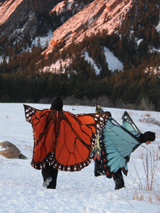Beth Osnes
Opening
2019
Photography, acrylic on repurposed bed sheets. Photograph by Isabel Cousins; butterflies by Beth Osnes, Juliana Forbes and Melisande Osnes; butterflies embodied by Sarah Fahmy (monarch) and Emmet Norris (blue morpho).
These butterflies are made from repurposed bed sheets from a secondhand store and curtain rods from various windows, now bare. I created the butterflies to embody the natural world and inspire feelings of opening and wonder. The butterflies have performed in Penn Station, at the Drawdown Learn conference, at climate strikes and, pictured here, for early morning hikers at Chautauqua Park. Stay tuned for more sightings. -- Beth Osnes
Striking for Transformation
2019
Photograph
Photography by Lianna Nixon; butterfly created by Beth Osnes, Juliana Forbes and Melisande Osnes; civic engagement by Young Womxn's Voices for Climate - Eliza Anderson, Lola D’Onofrio, Finny Guy, Olympia Kristl, Ting Lester, Uli Miller, Lerato Osnes, Leela Stoede, Sofie Wendell.
"If a dove is the symbol of peace, then a butterfly is the symbol of change," 16-year-old Finny Guy declared through a megaphone at the Sept. 20, 2019, climate strike. As shown in the photograph, Ting Lester stood by embodying the beauty of the butterfly, making present her commitment to transformational change needed in our policies and choices to reverse global warming. -- Beth Osnes
|



